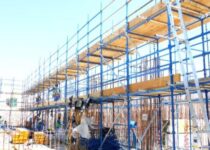Steel Scaffold Boards: Unmatched Durability vs LVL & Timber.

When it comes to scaffolding, the working platforms, the boards you stand on are the unsung heroes. They’re not just pieces of wood or metal; rather, they’re the difference between a safe workday and a dangerous one. Whether you’re on a high-rise in Dubai, an oil rig in Saudi Arabia, or an offshore platform in Qatar, these boards must be tough enough to withstand heavy loads, harsh weather, and rigorous safety checks. For a long time, standard softwood planks were all we had. Subsequently, LVL (Laminated Veneer Lumber) came along, a stronger, more advanced option that was a game-changer. However, with safety standards becoming increasingly stringent and job sites more demanding than ever, a new solution has emerged: Scaffold steel boards like SPARDECK from SPAR Steel. Consequently, they’re setting the new benchmark for what a steel scaffold board should be.
Engineering & Material Properties of Steel Boards, LVL & Softwood
SPARDECK Steel Boards are engineered from high-strength Q235/Q345 steel and are hot-dip galvanized for excellent corrosion resistance. Furthermore, they are equipped with anti-slip perforations, forged hooks, and drainage holes, and have a typical load capacity of 2.0–2.5 kN.
In comparison, LVL Boards, or Laminated Veneer Lumber, are made from adhesive-bonded veneers. While lightweight with moderate strength, they are more prone to delamination and have a lower typical load capacity of around 1.5 kN.
Lastly, Softwood Boards, made from spruce, pine, or fir, are the weakest and least durable option, with a typical load capacity of just 1.0–1.2 kN. As a result, they are also susceptible to splintering, warping in heat or moisture, and pose a higher fire risk, making them suitable only for light-duty or temporary applications.
Unmatched Safety, Durability, and Fire Resistance
Compliance: SPARDECK steel boards are fully compliant with major international standards, including OSHA 1926, EN 12811, EN 1004, and BS 1139. Consequently, this compliance ensures they meet strict requirements for load bearing, slip resistance, and fire safety, unlike LVL and softwood, which have limited compliance.
Durability: With a lifespan of 10–15 years, SPARDECK boards are built for extreme conditions. In fact, this is a significant advantage over LVL boards, which last only 3–5 years, and softwood boards, which last just 2–3 years and are highly vulnerable to rot and insects.
Fire Resistance: SPARDECK boards are 100% non-combustible, thereby offering the highest level of fire safety. This is a critical advantage over flame-retardant-treated but still combustible LVL boards and the highly flammable and unsafe softwood options.
Cost-Benefit Analysis (10-Year Outlook)
| Board Type | Initial Cost | Service Life | Replacement Cycle | Total Cost |
| Steel (SPARDECK) | Higher upfront | 10–15 yrs | Once | Lowest |
| LVL | Medium | 3–5 yrs | 2–3 times | Higher |
| Softwood | Low | 2–3 yrs | 3–5 times | Highest |
Industry Applications
Consequently, SPARDECK is suitable for demanding industries like oil & gas shutdowns, offshore rigs, LNG terminals, shipyards, and high-rise construction projects.
On the other hand, LVL Boards are commonly used in light construction, electrical works, and for temporary access platforms. Softwood boards are restricted to small-scale, low-risk housing or short-term applications.
SPARDECK Scaffold Steel Board: At a Glance

Material & Dimensions: Regarding materials and dimensions, SPARDECK Scaffold Steel Boards are made from Q235/Q345 steel. Furthermore, their standard dimensions are 210–240 mm wide, 38–45 mm thick, and 1.0–4.0 m in length. In addition, the weight varies depending on the specific size, ranging from 12–16 kg.
Performance & Finish: In terms of performance and finish, the boards have a load capacity of at least 2.0 kN per board. Moreover, they are hot-dip galvanized, with a zinc coating of at least 65 μm for superior corrosion resistance.
Compliance & Features: Finally, when it comes to compliance and features, the boards meet major safety standards, including OSHA 1926 (USA), EN 12811, EN 1004 (EU), and BS 1139 (UK). Additionally, their features include anti-slip holes, drainage, and forged hooks.
Annexure: Load-Span Calculations
| Length (m) | Supported Span (m) | Max Load (kN) | Deflection Limit | Compliance |
| 1.0 | 0.9 | 2.5 | L/200 | OSHA / EN 12811 |
| 1.5 | 1.3 | 2.0 | L/200 | BS 1139 |
| 2.0 | 1.5 | 1.8 | L/200 | EN 12811 |
| 2.5 | 2.0 | 1.5 | L/200 | EN 12811 |
| 3.0 | 2.2 | 1.2 | L/200 | EN 12811 |
Conclusion
Softwood boards are outdated and unsafe. While LVL offers some improvements, it falls short in durability and fire safety. Ultimately, SPARDECK Scaffold Steel Boards deliver unmatched strength, compliance, and cost efficiency.
Therefore, for procurement teams and engineers in oil & gas, petrochemicals, and construction, SPARDECK is the clear choice for scaffolding safety and reliability.
Learn more: www.sparsteel.com , and to get in contact info@sparsteel.com



